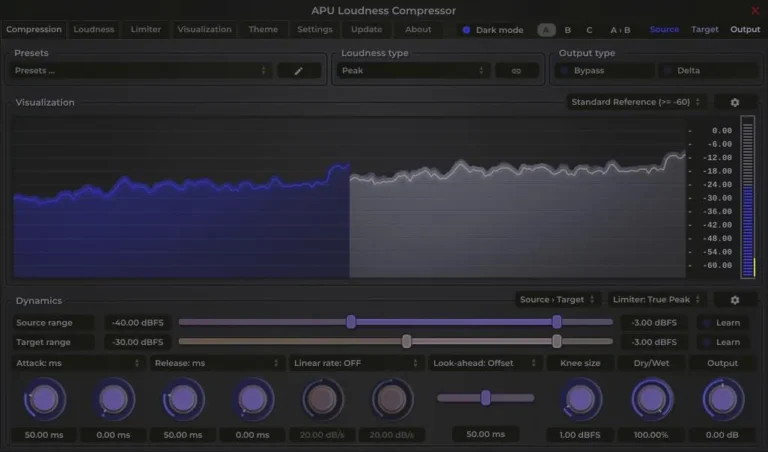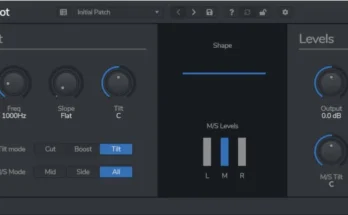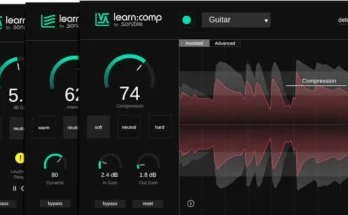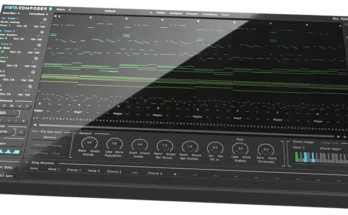APU Loudness Compressor is a compressor/expander designed to support modern loudness metering types (LUFS, True Peak). This means that the compression curve depends on LUFS measurements, rather than RMS or peak values. Since LUFS is a more accurate measure of loudness, the result is very transparent compression, making it particularly suitable for mastering and post-production. The compressor can also operate in a more traditional mode, using RMS and peak values, so you can get the best of both worlds.
APU Loudness Limiter is a tool designed for loudness limiting. Its primary function is to simultaneously limit volume using multiple measurement types, including modern LUFS standards (integrated, short-term, and instantaneous) and traditional metrics (RMS, peak, and true peak). The true peak limiter is designed to account for peak values between samples.
APU Loudness Compressor
By default, the compressor operates using the “source range” and “target range” controls instead of the threshold and ratio controls. You can also enable the traditional threshold and ratio controls if desired. The drop-down menu in the upper right corner of the “Compressor Dynamics” section allows you to switch between these operating modes and others, such as expander, limiter, and so on.
With “Learn” mode enabled, the compressor automatically adjusts the source or target range to the source material. This is a great way to get started with the compressor and can be used as a starting point for further fine-tuning.
Loudness Adjustment Options
One of the key features of this compressor is its support for various loudness adjustment types. The compressor’s detection scheme can be configured to use either LUFS or traditional units of measurement (RMS, peak). You can also split or link channels, which is especially useful for multi-channel audio formats such as Dolby Atmos®.
The compressor detection circuit can be configured to use any of the following volume types:
Instantaneous
mode measures LUFS over a short period of time (400 ms), which is useful for processing the dynamics of sound at any given moment. This mode is responsive yet transparent, making it a suitable default mode for the compressor. The compressor’s detection circuit uses K-weighting and channel weighting, improving perceptual accuracy.
Instantaneous LUFS
Short-Term is a LUFS measurement with a longer exposure time (3 seconds), which is useful for processing large-scale sound dynamics. Due to the longer exposure time, this mode is less sensitive than Instantaneous, but it can be useful for adjusting the overall sound dynamics. K-weighting and channel weighting are applied in the same way as with Instantaneous metering.
Short-term LUFS
RMS loudness measurement types use a sliding time interval of 300 ms. RMS is a traditional loudness measurement that is a good first-order approximation of perceived loudness. This mode does not use K-weighting or channel weighting in the compressor detection circuit, giving it a more traditional character.
True Peak Loudness (RMS)
measurements are similar to traditional peak loudness measurements, but are more accurate because they take into account peaks between samples. These measurements use a time interval equal to the specified block size (1 ms by default). This mode is characterized by a fast response speed, making it suitable for very fast attack and release times.
True
Peak Loudness Peak is a standard peaking scheme that operates over a time interval equal to the specified block size (1 ms by default). This is another measurement in the traditional compressor style. Technically, this mode is even slightly more sensitive than True Peak, but it is less accurate because it doesn’t take into account peaks between samples.
APU Loudness Limiter
The APU Loudness Limiter is a tool designed for loudness limiting. Its primary function is to simultaneously limit loudness using multiple measurement types, including modern LUFS (integrated, short-term, and instantaneous) standards and traditional metrics (RMS, peak, and true peak). The true peak limiter is designed to account for peak values between samples.
The limiter provides a number of controls for customizing its response. In addition to the standard “Threshold,” “Ceiling,” “Attack,” and “Response” parameters, it includes a predictive gain reduction feature.
A unique “Linear Response” mode provides a constant rate of gain change, unlike traditional ballistic envelopes, which can be used to achieve very fast response or to set a maximum response speed. You can also choose between “Natural” and the more sensitive “Inertial” ballistics modes with additional smoothing.
A key feature is the real-time visualization system, which displays the volume levels of the source, target, and output signals dynamically. You can switch between a history view and a histogram displaying the distribution of volume levels.
This display is easily customizable: you can change the layout of elements, colors, and even add aesthetic shader effects. The visualizer also includes built-in diagnostic tools, such as a “Residual Breathing Noise” function, which helps identify where the limiter is working hardest to achieve the target gain, and a snapshot system for comparing volume histograms.
For workflow, the limiter includes presets that meet the loudness and peak limits of various streaming services and broadcast standards, such as Spotify, Apple, and EBU R128. It also supports an external sidechain input for dynamics processing and uses a “budget” system for predictive control and attack time, allowing you to adjust these latency-causing parameters in real time without introducing audio artifacts.
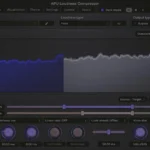
- Download APU Loudness Compressor 3.7.6 & Limiter 4.4.2 STANDALONE, VST3, AAX x64 [09.24.2025](“BTCR” “R2R”)
- Original Publisher: APU Software
- Version: 3.7.6 & 4.4.2
- Format: AAX, VST3, Standalone
- Category: VST Plugins
- Require: Windows 7+
- License type: Full
- Download Size: 50.1 MB

